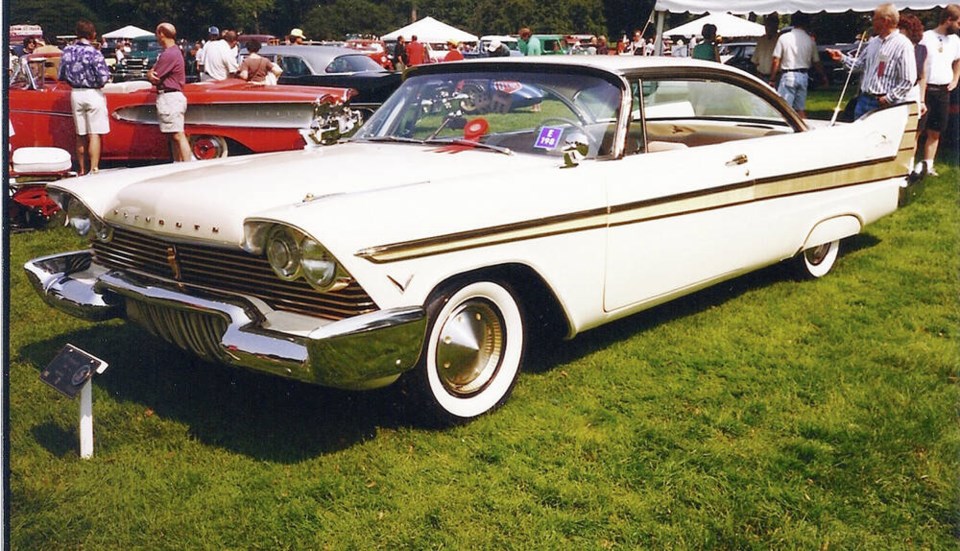The Plymouth brand was introduced in 1928 by Walter Chrysler’s Chrysler Corp. to give it a presence in the popular-priced field. It was a revamped Chrysler 52, a sensible, reliable workhorse car that easily made Chrysler part of the Big Three (GM, Ford and Chrysler). It helped Chrysler weather the 1930s Depression but was not considered a performance car.
The Ford V-8 introduced in 1932 and Hudson’s Terraplane were the popular-priced hot ones. Plymouth stayed with four cylinders until 1933, and its role was to provide sturdy, reliable service, which it did very well.
In spite of its rather staid image, during the years following the Second World War Plymouth’s vaunted reliability sometimes served it surprisingly well in both NASCAR and American Automobile Association (AAA) competition. While hot dogs like Lincolns and Oldsmobiles burned themselves out racing one another, Plymouth would often stroke quietly along to victory.
By the early 1950s, however, Oldsmobile 88s, Hudson Hornets and Chrysler Hemis were frequently leaving Plymouth in the shade.
After a period of sensible, staid design, things changed dramatically for Chrysler Corp. in 1955 when chief stylist Virgil Exner introduced his new “Forward Look” lines, relieving the corporation from a rather conservative styling period.
Plymouth scored twice in 1955: a daring new shape and the arrival of its new overhead valve V-8 engine developing 167 horsepower out of 4.3 litres (260 cu. in.). It was a big step up from the old side-valve six, although that venerable veteran would continue to be available until 1959.
In 1956, Plymouth further polished its image with the introduction of the car that brought it into the heady high performance league. The impetus came when Chrysler introduced the mighty 1955 Chrysler C300, prompting its other corporate divisions to demand their own sporty models. They came in 1956 as the De Soto Adventurer, Dodge D-500 and Plymouth Fury.
The Fury was an attractive white, two-door hardtop with an anodized aluminum gold-tinted side spear and taillights raised on tall fins. Inside was Chrysler’s newly introduced corporate push-button transmission control.
As the Fury was a specialty car, only 4,485 1956 models were produced. Not many in a mass-production market, but still more than the Chrysler 300B, De Soto Adventurer and Dodge D-500 combined.
Under the hood was a 5.0-litre (303 cu. in.) 240-horsepower V-8 with such modifications as 9.25:1 compression ratio, four-barrel carburetor and dual exhausts. This enabled the Fury to sprint from zero to 97 km/h (60 mph) in 10 seconds.
It also ran 200 km/h (124 mph) on the sands of Daytona Beach, Florida in advance of NASCAR’s annual Speed Week. It couldn’t compete officially because it hadn’t been in production long enough.
The V-8 engine was built in Chrysler’s Windsor, Ont., plant, a touch of irony because those early Furys were not available to Canadian buyers.
The 1957 Plymouth received the corporation’s new “Torsion-Aire” front suspension using longitudinal torsion bars reputed to give Chrysler products the best handling in the industry.
The electrical system was upgraded from six volts to 12, and when Fury buyers ordered an automatic transmission it was Chrysler’s new three-speed “TorqueFlite” unit, which had bowed in the 1956 Imperial to replace the two-speed “PowerFlite.”
The 1956 Plymouth’s rear fins had been raised slightly, then for 1957 all Chrysler products got Exner’s “Flite Sweep” design featuring soaring tailfins designed to take fin leadership away from General Motors. Those wing-like appendages along with the Plymouth’s flat, delicate roof, low beltline and large glass area made a powerful styling statement.
Although appearing rather overdone now, Chrysler Corp.’s 1957 models were considered very handsome cars in their day. The new look helped Plymouth jump over Buick in sales and return to its traditional third place behind Ford and Chevrolet.
For 1957, the Fury got a larger 5.2-litre (318 cu. in.), 290-horsepower V-8, and in 1958 this was increased again to 5.7 litres (350 cu. in.) and 305 horsepower, courtesy of De Soto’s “Golden Commando” engine.
It turned the ’58 Plymouth into a real tiger. Road & Track (3/58) recorded zero to 97 km/h (60 mph) in 8.0 seconds and top speed of 194 km/h (120.6 mph) with a manual transmission.
While the testers were impressed with the Fury’s performance, they were somewhat intimidated by its sheer size. It had a 2,997-mm (118 in.) wheelbase, was 5,232 mm (206 in.) long and weighed 1,776 kg (3,915 lb).
The Plymouth Fury became a full line of cars for 1959 as Chrysler began trading on the name’s prestige. And although Plymouth would continue to offer Furys, and some fast ones at that, it was those big, finned originals that changed Plymouth’s image by finally putting some “fury” into its performance.



